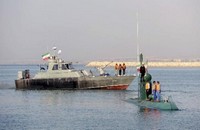Iran does not have the arsenal to back up its many threats
19:06 - 11 January 2012

The recent statements coming out of Iran, including by Vice President Mohamed Reza Rahimi, have threatened to close the Strait of Hormuz if the West imposes sanctions on Iranian oil exports. But the reality of the regime\'s limited military capacity makes this seem like more of a bluff than an actual plausible course of action.
One only has to refer back to the Iran-Iraq war in the 1980s, or even the recent capture of a US surveillance drone, to realise that the Iranians should not be underestimated. But it is also important to not allow their strategic bravado and inflammatory rhetoric to influence oil prices and the world economy. The Iranians should not be discounted, but equally they must not be overestimated.
Iran\'s recent Velayat 90, or \"Supremacy 90\", manoeuvres were intended to be a show of force to display its capabilities. It deployed anti-shipping missiles, anti-air missiles and small boats that would no doubt be important players if it did try to close the strait.
The exercise involved some actual real-world training, but the dominant component was to send a message to its neighbours. Some of the weapons systems, especially the 1960s-era F-4 fighters and helicopters, would be totally irrelevant and were probably included for reasons of prestige and propaganda. If Iran was more serious about closing the strait, then its manoeuvres would have been much more realistic.
But how real is Iran\'s capability if it did wish to start hostilities?
Firstly, the consequences of such an attempt must be taken into account. A naval conflict in a strait, where approximately 15 million barrels a day pass through, would send oil prices skyrocketing, greatly damaging the struggling world economy.
There is no doubt that the US and Nato, and possibly other major powers, would retaliate against such a move. An operation to try to restrict shipping in the strait would be an act of desperation and completely counterproductive.
Iran\'s conventional surface fleet would be sitting targets, and face annihilation from aerial attacks akin to what happened to Libya\'s mechanised ground forces in the recent Nato-led offensive. Its manoeuvres would be limited to simply trying to survive, which is one reason why Iran has not heavily invested in a surface fleet.
And there would not be much relief under the surface either. Iran\'s diesel-electric kilo class submarines are certainly much quieter than nuclear submarines, and they are also difficult to detect in the shallow waters of the Arabian Gulf. In 2006, a similar Chinese Song-class submarine approached the US aircraft carrier USS Kitty Hawk, coming undetected within striking distance before surfacing. But diesel-electric submarines need to surface every few days, leaving them vulnerable to attack.
Anti-shipping missiles (ASMs) are another weapon the Iranians could try to use. The location of strategic islands in the Gulf, along with large stockpiles of ASMs, makes them an important part of Iran\'s asymmetrical warfare doctrine. An ASM base on Qeshm Island at the mouth of the strait would be at the forefront of any attempt to halt traffic.
Iran\'s ASM models are designed for quick deployment and firing, and it\'s likely that the ASM crews have been trained to fire quickly and scatter to avoid retaliation. In 2003, Iran fired ASM missiles that had been modified to become guided cruise missiles. US forces had a very hard time locating and destroying the ASM launchers, and captured most of them intact and abandoned, sometimes days after they had been fired.
But nowadays there is much better drone and satellite reconnaissance to pinpoint and destroy ASM launcher and missile locations. Most surface ships in the Gulf are equipped with effective missile-intercept capabilities. If Iran chose to engage in ASM warfare, it could find itself fighting a losing battle of attrition.
Iran does have a fleet of small boats that numbers in the hundreds, some with the ability to fire lethal ASMs, but most are poorly equipped, modified speedboats with Katyusha rocket launchers and heavy machine guns. As the Somali pirate operations have shown, modified small boats can help achieve tactical surprise, but if intercepted by heavier vessels, the battle becomes one-sided due to the poor defensive capabilities and the lack of sophisticated armaments.
Possibly the most effective tool that the Iranians have is their mine warfare capability. The Iranians have an extensive (and underrated) naval mining capability, which can be launched from boats, planes, mini-submarines and even from the shore. Mines are the poor man\'s most lethal naval weapon. Since the end of the Second World War, mines have seriously damaged or sunk four times more US navy ships than all other means of attack combined.
Iran\'s naval mining capability looks like the wild card in such a conflict. There is no command and control structure in mine warfare that the US type of \"shock and awe\" strategy could effectively attack and destroy.
Overall, however, the naval warfare capabilities of the US, Nato and GCC have improved in recent years. There is much better mine countermeasures training, and a much wider choice of aerial and naval systems to deal with mines.
The combination of these weapons does mean that, if it chose, Iran could reduce Gulf maritime traffic through the strait in the short-term. Its limitations, however, mean that the affair would most likely be resolved in a matter of weeks.
BY: Ahmed Al Attar
Source - The National
One only has to refer back to the Iran-Iraq war in the 1980s, or even the recent capture of a US surveillance drone, to realise that the Iranians should not be underestimated. But it is also important to not allow their strategic bravado and inflammatory rhetoric to influence oil prices and the world economy. The Iranians should not be discounted, but equally they must not be overestimated.
Iran\'s recent Velayat 90, or \"Supremacy 90\", manoeuvres were intended to be a show of force to display its capabilities. It deployed anti-shipping missiles, anti-air missiles and small boats that would no doubt be important players if it did try to close the strait.
The exercise involved some actual real-world training, but the dominant component was to send a message to its neighbours. Some of the weapons systems, especially the 1960s-era F-4 fighters and helicopters, would be totally irrelevant and were probably included for reasons of prestige and propaganda. If Iran was more serious about closing the strait, then its manoeuvres would have been much more realistic.
But how real is Iran\'s capability if it did wish to start hostilities?
Firstly, the consequences of such an attempt must be taken into account. A naval conflict in a strait, where approximately 15 million barrels a day pass through, would send oil prices skyrocketing, greatly damaging the struggling world economy.
There is no doubt that the US and Nato, and possibly other major powers, would retaliate against such a move. An operation to try to restrict shipping in the strait would be an act of desperation and completely counterproductive.
Iran\'s conventional surface fleet would be sitting targets, and face annihilation from aerial attacks akin to what happened to Libya\'s mechanised ground forces in the recent Nato-led offensive. Its manoeuvres would be limited to simply trying to survive, which is one reason why Iran has not heavily invested in a surface fleet.
And there would not be much relief under the surface either. Iran\'s diesel-electric kilo class submarines are certainly much quieter than nuclear submarines, and they are also difficult to detect in the shallow waters of the Arabian Gulf. In 2006, a similar Chinese Song-class submarine approached the US aircraft carrier USS Kitty Hawk, coming undetected within striking distance before surfacing. But diesel-electric submarines need to surface every few days, leaving them vulnerable to attack.
Anti-shipping missiles (ASMs) are another weapon the Iranians could try to use. The location of strategic islands in the Gulf, along with large stockpiles of ASMs, makes them an important part of Iran\'s asymmetrical warfare doctrine. An ASM base on Qeshm Island at the mouth of the strait would be at the forefront of any attempt to halt traffic.
Iran\'s ASM models are designed for quick deployment and firing, and it\'s likely that the ASM crews have been trained to fire quickly and scatter to avoid retaliation. In 2003, Iran fired ASM missiles that had been modified to become guided cruise missiles. US forces had a very hard time locating and destroying the ASM launchers, and captured most of them intact and abandoned, sometimes days after they had been fired.
But nowadays there is much better drone and satellite reconnaissance to pinpoint and destroy ASM launcher and missile locations. Most surface ships in the Gulf are equipped with effective missile-intercept capabilities. If Iran chose to engage in ASM warfare, it could find itself fighting a losing battle of attrition.
Iran does have a fleet of small boats that numbers in the hundreds, some with the ability to fire lethal ASMs, but most are poorly equipped, modified speedboats with Katyusha rocket launchers and heavy machine guns. As the Somali pirate operations have shown, modified small boats can help achieve tactical surprise, but if intercepted by heavier vessels, the battle becomes one-sided due to the poor defensive capabilities and the lack of sophisticated armaments.
Possibly the most effective tool that the Iranians have is their mine warfare capability. The Iranians have an extensive (and underrated) naval mining capability, which can be launched from boats, planes, mini-submarines and even from the shore. Mines are the poor man\'s most lethal naval weapon. Since the end of the Second World War, mines have seriously damaged or sunk four times more US navy ships than all other means of attack combined.
Iran\'s naval mining capability looks like the wild card in such a conflict. There is no command and control structure in mine warfare that the US type of \"shock and awe\" strategy could effectively attack and destroy.
Overall, however, the naval warfare capabilities of the US, Nato and GCC have improved in recent years. There is much better mine countermeasures training, and a much wider choice of aerial and naval systems to deal with mines.
The combination of these weapons does mean that, if it chose, Iran could reduce Gulf maritime traffic through the strait in the short-term. Its limitations, however, mean that the affair would most likely be resolved in a matter of weeks.
BY: Ahmed Al Attar
Source - The National



